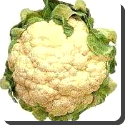 Cauliflower — Cauliflower is one of several vegetables in the species Brassica oleracea, in the family Brassicaceae. It is an annual plant that reproduces by seed. Typically, only the head (the white curd) is eaten while the stalk and surrounding thick, green leaves are discarded. Cauliflower is very nutritious, and may be eaten cooked, raw or pickled.
Cauliflower — Cauliflower is one of several vegetables in the species Brassica oleracea, in the family Brassicaceae. It is an annual plant that reproduces by seed. Typically, only the head (the white curd) is eaten while the stalk and surrounding thick, green leaves are discarded. Cauliflower is very nutritious, and may be eaten cooked, raw or pickled.
Its name is a variation of cole flower or kale flower (cole and kale being variations of the same word), an acknowledgment of its unusual place among a family of food plants which normally produces only leafy greens for eating. The Brassica oleracea species is the same species as cabbage, brussels sprouts, kale, broccoli and collard greens, though they are of different cultivar groups.
The preferred garden soil for cauliflower is well drained, moist and has significant organic matter with a pH of 6 to 7. Cauliflower is typically started indoors six to eight weeks prior to setting out in the garden and is typically ready for harvest two months after transplanting. As with all brassicas, seeds germinate best with a soil temperature of 25±1 °C (77±2 °F). The vegetable requires a cool, moist climate – if temperatures go too high, the plants will not produce flower heads, if too low a temperature is reached, the plants might button, creating small heads. It is cold tolerant, but will not survive hard frosts. Of all the brassicas, cauliflowers have the largest number of growth requirements, and the ability to successfully grow cauliflower in a home garden is often thought to be the hallmark of well-managed soil and a good gardener.
The most common insect pests of cauliflower are cabbage worms. Aphids and flea beetles will also attack cauliflower. Control of pests can be achieved by using biological controls such as using geraniums and borage as companion plants to repel pests, the Bacillus thurengensis bacterium, predatory insects or chemical pesticides. Diseases of cauliflower include black rot, club root and viral yellows. Crop rotation helps to prevent fungal and bacterial diseases. The viral diseases are primarily spread by insects.
Cauliflower is low in fat, high in dietary fiber, folate, water and vitamin C, possessing a very high nutritional density. As a member of the brassica family, cauliflower shares with broccoli and cabbage several phytochemicals which are beneficial to human health, including sulforaphane, an anti-cancer compound released when cauliflower is chopped or chewed. In addition, the compound indole-3-carbinol, which appears to work as an anti-estrogen, appears to slow or prevent the growth of tumors of the breast and prostate. Cauliflower also contains other glucosinolates besides sulfurophane, substances which may improve the liver’s ability to detoxify carcinogenic substances. A high intake of cauliflower has been found to reduce the risk of aggressive prostate cancer.
 Kids Portal For Parents India Kids Network
Kids Portal For Parents India Kids Network






